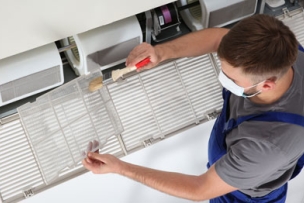Sometimes, wet floors aren’t caused by overspray, overfills or spills. When the problem is a leaky roof or condensation from overhead piping, those constant drips are more than just an annoyance. They create slip hazards that can be widespread and in unexpected areas. So how do you manage these particular safety risks in the most thorough, safe and aesthetically pleasing way?
Leaky Roofs
Roof leaks can wreck ceilings, spoil inventory, destroy electronic devices and leave puddles on the floor. It may also be impossible to fix the leaks immediately if the season is too wet or too cold to make the necessary repairs outside on the roof. Placing buckets and garbage cans in aisles and walkways to catch roof leak drips is a common, temporary solution that looks awful and can create trip and spill hazards. They also need to be tended and emptied so that they don’t overflow. If the drips happen above workstations, electronic damage and additional hazards could be present. Not to mention, employees may not be too thrilled about having buckets on their desks or workbenches.
If the roof is accessible and it is safe to make a temporary repair, rapid repair compounds can be used to stop leaks and buy some time until permanent repairs are possible. When the roof is not accessible due to weather or other factors, roof leak diverters are an alternative. They also come in handy when there are enough roof leaks that some repairs must be deferred. Because they are deployed under the roof but over work areas, roof leak diverters keep aisles and walkways clear while channeling water to floor drains or more discrete collection areas.
Pipe Condensation
Condensation on pipes may be a constant issue caused by the flow of hot or cold liquids, or it may be a seasonal occurrence produced by humidity or temperature extremes. Regardless, the result is a line of water on the floor beneath each pipe. Trough-style leak diverter tarps under piping can catch and channel condensation to a collection area or drain. Also, adhesive-backed floor mats can soak up the condensation while adding traction in aisles and walkways.
Whether overhead drips are from a leaky roof or from condensation, being prepared can minimize further damage and downtime. Controlling them helps keep your facility safer by minimizing the chance of slip, trip and fall injuries.
Previously Featured on New PIG's blog.



Talk to Us!
Leave a reply
Your email address will not be published. Required fields are marked *